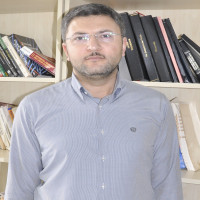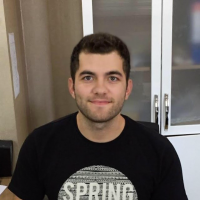Research Article
Aim & Scope
Journal of Innovative Science and Engineering is an international multidisciplinary peer-reviewed journal that dedicated to publishing high-quality research in the fields of basic and applied Sciences and a wide range of subfields in Engineering. JISE publishes two issues per year. At least 10 articles are published per year.
The journal accepts manuscripts from researchers, academicians and professionals all over the world to combine, promote, share, and discuss new ideas, issues, and developments. Submitted articles will be reviewed by Scientific Committees of the Journal.
Author Guidelines
1. General
This document presents instructions for authors who are preparing a manuscript to submit to Journal of Innovative Science and Engineering (JISE). Manuscripts for consideration should be submitted to the Editorial Manager via online system (Dergipark) once you have read the author guidelines below.
Submission of a manuscript implies that the work has been submitted only to JISE; that it has not been previously published, nor it is under consideration for publication or in press elsewhere; that its publication has been approved by all co-authors. JISE will not be held legally responsible if authors fail to follow this condition.
1.1 Article Type
JISE publishes only scientific research articles. Research articles should report results of an original scientific study where conclusions are based on significant findings after thorough evaluation of the topic.
The manuscript should be compiled in the following order: title page (including title, author’s affiliations, abstract, keywords); main text (introduction, materials and methods, results and discussion, conclusion); acknowledgements (funding and grant-awarding bodies); references; supplemental material (as appropriate).
1.2 Format
The manuscript should be prepared on MS Word processor, in single line spaced using Times New Roman font on an A4 format with margins of 1.5 cm from all sides. All pages should be numbered consecutively. Manuscripts will not exceed 30 printed pages including; title page, main text, acknowledgements, tables and figures, and references.
1.3 Language
The manuscripts are accepted in English. It is the responsibility of the author to assure that the article is written in a clear and concise language. Manuscript submitted in poor quality and insufficient English will be rejected during pre-evaluation process. If English is not your native language, you may want to have your manuscript edited by a native speaker prior to submission.
2. Title Page
2.1 Title
Title should be written using bold type and Times New Roman font size 14 with lower case letters and center aligned. The title should be concise and informative, yet the number of words in the title should be limited to those words that highlight the significant content of the article. The title should not contain less common acronyms.
2.2 Author Information
Leaving one line after title, name(s) of author(s) should be written using bold type Times New Roman font size 11 with capital letters for the first letters of the words with center aligned, adding superscript numbers (i.e. 1, 2, 3) at the end of last name of each author. Corresponding author should be indicated with asterisk.
Leaving one line after name(s) of author(s), their affiliations and postal address should be written using Times New Roman font size 10 with capital letters for the first letters of the words with left alignment. The e-mail address should be also given for corresponding author in affiliation line.
2.3 Abstract and Keywords
The Abstract should be written using Times New Roman font size 10 and justified. The Abstract of 300 words should state the objectives and results of the work described. The Abstract should not contain any undefined abbreviations. Leaving one line after Abstract, there should be up to six keywords with capital letters for the first letter of each keyword using Times New Roman font size 10. Mathematics and references are not permitted in the abstract.
3. Main Text
The main body of the text should comprise “Introduction”, “Materials and Methods”, “Results and Discussion” and “Conclusion” sections. One line after each section should be left and text should be started leaving one line after section headings.
Introduction: It should contain the problem being researched, give an overview of earlier studies on the subject, and define the state of current studies. Please also state briefly and clearly the purpose of writing the article.
Materials and Methods: This section should present materials used in the study and the research procedure in detail.
Results and Discussion: The results of the study and the discussion should be grouped together, although sometimes, these sections are to be separate chapters. Results and Discussion should contain synthesis and discussion concerning previous studies on the subject. The corresponding tables and pictures should be provided in this section. However, the same data must not be displayed in two ways, e.g. graphically and in a table.
Conclusion: This section should summarize the main findings and also link to the recommendations.
Main section headings and subheadings should be written using bold type Times New Roman size 11 with capital letters for the first letter of each word in headings. The headings should be numbered consecutively (i.e. 1. Introduction, 2. Materials and Methods, 2.1 Study Area …). The sub-headings should be limited to three levels.
Scientific names in the article (such as plant and animal names) should be in italics. Internationally accepted signs and symbols should be used for units (SI units). Abbreviations should be defined at first mention and used consistently thereafter. Footnotes can be used to give additional information, which may include the citation of a reference included in the reference list.
4. Acknowledgements
Acknowledgments of people, grants, funds, etc. should be placed in a separate section at the end of the main text before the reference list. The names of funding organizations and grant-awarding bodies should be written in full.
5. Tables and Figures
All tables and figures are to be numbered using Arabic numerals and always be cited in the text in consecutive numerical order (i.e. Figure 1, Table 1 …). Tables and figures should be embedded in proper places in the text. The table and figure captions are to be written in Times New Roman font size 10. Any previously published material should be identified by giving the original source in the form of a reference at the end of the captions.
The content of the tables and figures should be in a Times New Roman font size 10. For tables and figures, the maximum width and height is 14 cm and 20 cm, respectively. Photos or pictures in the figures should have a minimum resolution of 300 dpi. The authors can use color art in tables and figures free of charge. Tables should not contain vertical lines. Figure parts are to be denoted by lowercase letters (a, b, c …). Do not include titles or captions within your figures.
6. References
The references should only include works that are cited in the manuscript and that are published or accepted for publication. Unpublished results and information obtained through articles and personal communications are not recommended for use as the reference. Printed stage in the resources, if any, should be given a DOI number. All references must be numbered consecutively and citations of references in text should be identified using numbers in square brackets (e.g., “as discussed by Smith [9]”; “as discussed elsewhere [9, 10]”).
All references cited and reference’s name of the author, journal name/book title, section title/article title, year of publication, volume number/book chapters and paging should be available. Abbreviated journal names and book titles can be used in references.
For Journal Article
Author’s Surname, Initials. (Year). Title. Journal, Volume (Issue): Pages.
[1] Pawlak, A., Rosienkiewicz, M. and Chlebus, R. (2017). Design of Experiments Approach in AZ31 Powder Selective Laser Melting Process Optimization. Archives of Civil and Mechanical Engineering, 17(1): 9-18.
For a Book and Chapter
Author’s Surname, Initials. (Year). Title. Publisher, Place of publication, Edition, Number of pages. ISBN.
[2] Tro, N.J. (2013). Chemistry: A Molecular Approach, Pearson, Cambridge, UK, 3rd Edition, 1272 p. ISBN-10: 0321809246.
Author’s Surname, Initials. (Year). Section title, Book title, Editor(s), Publisher, Place of publication, Pages. ISBN.
[3] Akay, A.E. and Sessions, J. (2005). Forest Operations: Roading and Transport Operations, Encyclopedia of Forest Sciences, Edited by Jeffery Burley, Julian Evans, and John A. Youngquist, Elsevier Limited, Oxford, UK. pp. 259-269. ISBN: 0-12-145160-7.
For a Congress or Symposium
Author’s Surname, Initials. (Year). Title. Name of the event, Place of congress, Date. Pages.
[4] Crosson, E. and Harrow, A.W. (2016). Simulated Quantum Annealing Can Be Exponentially Faster Than Classical Simulated Annealing, IEEE 57th Annual Symposium on Foundations of Computer Science, New Brunswick, NJ, USA, 9-11 October 2016. pp. 714-723.
For a Thesis
Author’s Surname, Initials. (Print Year). Title, MSc / PhD Thesis, University, Place. Number of pages.
[5] David, R. (2017). Molecular Dynamics Simulations of Metallic Glass Formation and Structure, PhD Thesis. Ohio State University, Columbus, OH, USA. 217 p.
Electronic Source (Web documents)
Author’s Surname, Initials. (Year). Title. Web address [Accessed: day month year]
[6] Specavek, J.A. (2015). Fracking and the Stresses it Adds to Railroads. http://www.rheothing.com/2015/05/fracking-and-stress-adds-to-railroads.html [Accessed: 9 June 2015]
7. After Acceptance
Upon acceptance of your manuscript, you will receive the proofs to check for typesetting or conversion errors and the completeness and accuracy of the text, tables and figures. At this stage, extensive changes in content (e.g. new results, corrected values, title and authorship) are not allowed. After receipt of the corrected proofs, the article in PDF format will be published online.
Ethical Principles and Publication Policy
Publication Ethics
Effective studies are studies that embody and support the scientific method. It is important that all stakeholders (writers, readers and researchers, publishers, referees and editors) in this point must comply with the standards for ethical principles. Within the framework of the Journal of Innovative Science and Engineering (JISE) publication, all stakeholders are expected to carry out ethical responsibilities. Within this context, the policies of ‘publication ethics’ and ‘open access’ also require all components of publication process to obey the ethical principles, in direction of guides and policies of Committee on Publication Ethics (COPE), as “Code of Conduct and Best Practice Guidelines for Journal Editors” and “COPE Best Practice Guidelines for Journal Editors”.
In case we identify that author(s) of the manuscript use(s) falsified and fabricated data, then we will report this to the institution of the authors where he/she works and reject the manuscript. Editorial members of the journal and/or the reviewers reserve the right to ask author(s) to provide raw data which was used in the manuscript.
Editors' Ethical Responsibilities
1. All publications are judged on the basis of their intellectual content, regardless of the author's gender, race, ethnicity, religion, citizenship and political values.
2. Personal information about the articles is kept confidential.
3. The conflict of interest observed regarding the article must be explained.
4. The Editorial Board assumes the responsibility to make publishing decisions for the submitted articles, based on the evaluation of the candidate's articles, the editorial board policies of the journal, and the legally prohibited items against plagiarism and copyright infringement.
Referees' Ethical Responsibilities
1. They accept only to evaluate the work related to the field of expertise.
2. They should evaluate within impartiality and confidentiality.
3. If author (s) think that they are confronted with a conflict of interest during the evaluation process, they should refuse to examine the work and inform the editor of the journal.
4. The privacy policy should destroy the work that has been reviewed by the review process. Only the final versions of the studies can be used after publication.
5. Assessment should be done objectively only with respect to the content of the work. Nationality, gender, religious beliefs, political beliefs and commercial concerns should not allow it to influence the evaluation.
6. Use a polite language when making an assessment. Avoid humiliating personal interpretations of hostility, slander and insults.
7. The evaluation should be carried out on time and on the above ethical responsibility
Authors' Ethical Responsibilities
1. The work submitted for publication must have not been published in another journal or submitted at the same time. Each application can be started following the completion of the previous application. Published work in another journal cannot be sent to JISE.
2. Author (s) cannot have their work in the application process of more than one journal at the same time. Each application can be started following the completion of the previous application. Published work in another magazine cannot be sent to the journal.
3. Author (s) are required to make use of and / or quote in a complete and accurate way in order to benefit from other studies or to use other studies. In writing citation and bibliography, the APA 6 editorial guidelines should be considered.
4. Author (s) are aware of that of all submissions are screened by a similarity detection software at any point during the peer-review or publication process.
5. If all work submitted for publication is to constitute a conflict of interest, and if relevant, should be indicated.
6. The editor (s) may request raw data on their framing of evaluation processes; in such a case the author (s) should be ready to submit the expected data and information to the editorial board.
7. The author (s) has an obligation to cooperate with the editor in informing, correcting or withdrawing the journal editor or publisher if he / she finds a mistake or error related to his / her early published or evaluation work.
8. The author (s) must have evidence that they have the necessary permissions including ethical council permission if necessary for the use rights of the data used, research / measurement tools / analyzes.
9. Authors are responsible for their manuscripts' conformity to ethical rules. If the work has been done after ethics committee approval, any necessary permission documents from local and international ethic committees must also be sent with the manuscript, and the author should ensure that the manuscript contains a statement that the work has been approved by the ethics committee.
10. All financial supports should be mentioned in the “Acknowledgements” section.
11. Responsibilities of statements or opinions expressed in the manuscripts published in JISE solely belong to the author(s).
Plagiarism Rules
All manuscripts submitted to JISE will be subjected to plagiarism detection softwares. Manuscripts in which references sections truncated found to have similarity index of 20% or above and will be rejected. The acceptable limit for similarity of text from a single source is 5%.
Withdrawal Rules
Withdrawal of a manuscript will be permitted only for the most compelling and unavoidable reasons. If the author wish to withdraw paper from a journal, author needs to submit an "Article withdrawal Form" signed by all authors (or) the corresponding author of the manuscript stating the reasons for manuscript withdrawal. The form is available from the Editorial Office of the journal.
Price Policy
Journal of Innovative Science and Engineering (JISE) is an open access journal which means that all content is freely available without charge to the user or his/her institution. There are no article processing charges (APCs) nor article submission charges for authors. Thus, the accepted manuscripts are published online in JISE without any fee being charged.
Indexes
Citation Indexes
Other Indexes
Journal Boards
Owner (BTU Rector)

Editör-in-Chief

He received B.S. degree in Physics from Middle East Technical University in 2005. Then he received the M.S. degree in Electrical and Electronics Engineering from Atılım University in 2009. After that he received the Ph.D degree in Electrical and Electronics Engineering from Atatürk University in 2013. His currently research area is wave diffraction, reflection, propagation, shielding and wireless sensor networks. He is currently working at Bursa Technical University in Electrical and Electronics Engineering department.
Associate Editors
He received his Bachelor's, Master's and PhD degrees from Marmara University. His research interests include Machine Learning, Artificial Intelligence, Internet of Things, High Performance Computing.

Dr. Cagatay Tasdemir is currently working as an Associate Professor at Bursa Technical University. He continues to involve with research, teaching, and supervising activities within the Department of Forest Industry Engineering, Department of Industrial Engineering, and Department of Biocomposite Engineering at Bursa Technical University, Türkiye. He received his M.S. degree from Oklahoma State University, USA, and completed his Ph.D. at Purdue University, USA. He is specialized in Lean and Sustainable Supply Chain Management, while his other research areas include Six-sigma Quality Optimization, Industry Innovation, and Demand Management and Forecasting.

Subject Editors



He received his Bachelor's and Master's from Marmara University, and PhD degree from Istanbul Commerce University. His research interests include Machine Learning, Data Security and Protection, Chaos-based Image Encryption, Speech Recognition, Biomedical Signal Processing.

 Web
Web
Merhaba ben Doruk Ayberkin. 1981 yılında Mersin'de doğdum. Evli ve iki çocuk babasıyım. 2008 yılında Gazi Üniversitesi Fen Fakültesi Fizik Bölümü'nden mezun oldum. 2003-2009 yılları arasında Ankara'da özel sektörde yazılım uzmanı gibi unvanlar ile çalışarak çeşitli kurum ve kuruluşların yazılım projelerinde aktif olarak yer aldım. Botaş ERP projesi, Çevre ve Orman Bakanlığı ERP Projesi, TÜRMOB ve İSMMO yazılım geliştirme projeleri çalıştığım projelerden bazılarıdır.
2009 yılında özel sektördeki görevimden ayrılarak Bayburt Üniversitesi Bayburt Meslek Yüksekokulu Bilgisayar Programcılığı Bölümü'nde Öğretim Görevlisi olarak çalışmaya başladım. 2009-2012 yılları arasında Öğretim Görevlisi olarak görev yaptığım süre boyunca Bayburt Üniversitesi Bilgi İşlem Direktörlüğü bünyesindeki yazılımların geliştirilmesine ve süreçlerin dijitalleştirilmesine katkıda bulundum.
2012 yılında Hoca Ahmet Yesevi Uluslararası Türk-Kazak Üniversitesi Bilgisayar Mühendisliği Yüksek Lisans programından mezun oldum. 2017 yılında Atatürk Üniversitesi'nde Yönetim Bilişim Sistemleri alanında doktora çalışmalarıma başladım ve 2022 yılında doktora derecemi aldım. "Yenilik ve Kullanılabilirliğe Önem Vererek Dijital Pazarlama Sektöründe Blockchain Teknolojisinin Uygulanması için Bir Sistem Mimarisinin Tasarımı" başlıklı tezimle derecemi aldım. Şubat 2023 tarihi itibariyle Bayburt Üniversitesi Yönetim Bilişim Sistemleri Bölümü'nde Doktor Öğretim Üyesi olarak çalışmaktayım. Aynı zamanda Bayburt Üniversitesi Dijital Dönüşüm Ofisi'nde görev yapmaktayım.
Akademik kariyerim boyunca Bilgisayar Yazılımı, Sistem Tasarımı, Karar Destek Sistemleri ve Dağıtık Sistemler alanlarında çeşitli projeler üstlendim. Ayrıca bu konularda ulusal ve uluslararası dergi ve konferanslarda makalelerim yayınlandı ve sözlü sunumlar yaptım.
Şu anda araştırmalarım yenilikçi ve yaratıcı çözümler üretmeye odaklanıyor. Bunu gerçekleştirmek için başta "Blockchain Teknolojisi", "Yapay Zeka Algoritmaları" ve "Çok Kriterli Karar Verme" olmak üzere çeşitli alanlardaki önemli konuları ele alan akademik çalışmalar yürütüyorum.

Deniz Uzunsoy is the appointed Professor of Metallurgy & Materials in Bursa Technical University. She received her PhD in Materials Science from The University of Birmingham-UK (2003) and BSc(Eng) in Materials & Metallurgy from Yıldız Technical University- Istanbul-Türkiye. She specializes in the field of physical and powder metallurgy, as well as nanotechnology. Her research is focussed on the understanding of the relationship between processing, microstructure and properties of materials for industrial applications in transport, energy, defence and electronic sectors.
She holds 1 patent and has published over 85 research papers in scientific journals and conference proceedings. She is a Fellow of Powder Metallurgy Associtaion.
Her current research interest includes muticomponent lightweight alloys, high entropy alloys, additive manufacturing and 3D printing, nanocomposites, graphene.


Makine Mühendisliği, Otomotiv Mühendisliği, Taşıt Dinamiği, Taşıt Sistemleri ve Kontrol, İçten Yanmalı Motorlar

Dr. Gökçe TANER is an assistant professor at the Department of Bioengineering in Bursa Technical University in Bursa, Turkey. The academic degrees of Dr. Taner are as follows: M.Sc., Department of Molecular Biology and Genetics, Institute of Science and Technology, Gazi University, Ankara, Turkey, 2007; Ph.D., Department of Molecular Biology and Genetics, Institute of Science and Technology, Gazi University, Ankara, Turkey, 2015. She worked as a PhD student at Department of Pharmaceutical Toxicology in Hacettepe University, Faculty of Pharmacy; Ankara/Turkey; 2010-2015. She worked in INRA-TOXALIM, Research Center in Food Toxicology, Toulouse/ France and studied as a visiting scientist with Genotoxicity and Signaling Research Team for six months in 2013. She had supported with the Undergraduate Basic Sciences Scholarship (2001-2004) and International Research Fellowship Scholarship (2013) of The Scientific & Technological Research Council of Turkey. She is the members of Turkish Societies of Toxicology, EUROTOX, IUTOX and Turkish Society of Medical Biology and Genetics.
Her research area is genetic toxicology and cytogenetics. Scientific interests include antioxidant, cytotoxic, genotoxic and antigenotoxic effects of natural substances; Protective and therapeutic effects of antioxidant phenolic compounds in experimental models of disease; Cytocompatibility of biomaterials; Nanogenotoxicology, Determination of the effects of nanomaterials and nanoparticles on cells and DNA damage, and also genotoxic effects of food additives, and pesticides in cultured cells and in mouse bone marrow and tissues. She also has experiences on molecular biology and cell culture applications.


Mustafa Kocakulak received the B.Sc. degree in Electrical and Electronics Engineering in 2012 from Bilkent University. He received M.Sc. and PhD degrees in Mechatronics Engineering, in 2015 and 2023, respectively, from Bursa Technical University. From 2018 to 2019, he was a Visiting Student Researcher at The Autonomous University of Madrid (UAM). He is working as Assistant Professor at Department of Artificial Intelligence and Machine Learning at Bursa Technical University. His current research interests include image processing, reinforcement learning and deep learning tools for biometrics.




Editorial Board

He was born and completed his pre-university education in Isparta. In 1984, he completed secondary school as the top student among 500 students (9.76/10.00: Isparta Merkez Ortaokulu) and was a team leader at the National TUBITAK Mathematics Competitions. In 1987, he completed high school as the top student among 800 students (9.87/10.00): Isparta SAIK High School) and got the mansion in the National TUBITAK Chemistry competitions. In the same year in 1987, he was, among 1/2 million students, over 99.8% in both the First Stage of Turkey's University Exam and the Second Stage of Turkey's University Exam.
He received his B.S.E.E. from Hacettepe University (1993 -one semester delayed), Ms. E.E. from Gebze Institute of Technology (1997), and Ph.D. in EE from Sakarya University (2005). During his Ph.D. studies, he was with the National Centre for Plasma Science & Technology at Dublin City University (2005, Ireland). In 2006, he was a fellow researcher at the University of New Mexico (USA) at the High-Power Electromagnetic Laboratory. He started his career with Goltas Cement Factory as a control engineer developing PLC codes in the AEG Modicon S5 platform for the factory Line-2 modernization project. By January 1994, he joined the Space Technologies Department (to UEKAE in 1996) at TUBITAK as a researcher. He spent five years of experience on radio telescope design, EMC platforms, facilities, military and civil-based EMC Tests, including MIL-STD 461-462 and some industrial projects between 1993 and 1998. He was a trainee in EMC measurement techniques and EMC perspectives in circuit design at the University of Missouri Rolla (USA, 1997). Between 1998 and 2002, he got industrial experience in GSM RF planning and optimization at TURKCELL, MOTOROLA, NEXTEL, AT&T, LUCENT Technologies, Saudi Telecom, AVEA, and ERICSSON as an RF Planning and Optimization Expert. He was with MOTOROLA as a regional manager between 2000 and 2001. He founded an RF planning company named Ant Neptune Telecommunication Limited and managed international projects between 2001 and 2003. In 2003, he returned to academic studies at S. Demirel University (Turkey) as a lecturer. He held the position of vice director at BAUM. He was with Dublin City University (Ireland, in 2004 and 2005) for his Ph.D. studies and with the University of New Mexico (USA) as a fellow researcher in 2006. He has been a member of Akdeniz University as an Assistant Professor in the Electrical and Electronics Engineering Department since 2006 and as an Associate Professor in the same department since 2012. He has also been a director of the Industrial and Medical Application Microwave Research Center (EMUMAM) since 2008. During 2010 and 2014, he was vice managerial at TUBITAK National Observatory. He was a member of the Board of Directors of Antalya Technopark between 2008 and 2012.
His research interests span a wide range of topics, including microwave propagation, radar systems, EMC, EMI, WiMAX and WiMAX-based video transmission, backbone and capacity planning for telecommunication systems, and optical polarimeters and communication. In addition to his research, he is also deeply interested in project management, total quality management, and university-industry relations, further demonstrating his comprehensive expertise in the field.
Total R&D Project Grand is over 4,000,000 USD (Managed)
Total R&D Project Grand is over 10,000,000 USD (Participated and Managed)
The total Telecommunication project budget is over 20,000,000 USD (Participated and
Managed)
Mohd Nizar Hamidon is a Professor at the Department of Electrical and Electronic Engineering, Universiti Putra Malaysia (UPM), and former Director of the Institute of Nanoscience and Nanotechnology (2017–2024). He holds a B.Sc. in Physics (Universiti Malaya, 1995), an M.Sc. in Microelectronics (Universiti Kebangsaan Malaysia, 2001), and a Ph.D. in Electronic and Electrical Engineering (University of Southampton, UK, 2005).
With over two decades at UPM, he has led research programs in electronic devices, focusing on oxide and carbon-based materials for sensor systems (gas, pressure, wireless). His work has been funded by international, governmental, and university grants, resulting in 250+ publications, book chapters, and the graduation of 11 Ph.D. and 15 M.Sc. students. He founded Serdang Paste Technology Sdn. Bhd., a startup commercializing research innovations.
An active collaborator with researchers from Turkey, Japan, Indonesia, and Thailand, he has also consulted for Malaysia’s Ministry of Communication on WSN-based monitoring systems. A frequent speaker at international conferences, he has served as an IEEE conference organizer, reviewer, and past Chair of the IEEE Electron Device Malaysia Chapter. His contributions bridge academia, industry, and policy in nanotechnology and sensor development
1984 yılında Bursa’da doğan Evren MUTLUGÜN, 2005 yılında Orta Doğu Teknik Üniversitesi Fizik Bölümünden lisans derecesini almıştır. 2007 yılında yüksek lisans, 2011 yılında
doktora çalışmalarını Bilkent Üniversitesi Fizik Bölümünde tamamlamıştır. Doktora çalışmaları süresince yarıiletken nanokristal temelli eksitonik etkileşimler üzerine araştırmalar yapmış, doktora sonrası araştırma çalışmaları için Singapur’da Nanyang Teknoloji Üniversitesi (NTU) Elektrik-Elektronik Mühendisliği Bölümüne katılmıştır. 2012-2014 yılları arasında NTU’da nanokristal içeren elektrolüminesant aygıtlar konusunda çalışmalarda bulunmuştur. 2014 yılında Abdullah Gül Üniversitesinde görev yapmaya başlayan Evren MUTLUGÜN, Mayıs 2022’den günümüze Abdullah Gül Üniversitesinde profesör olarak çalışmalarına devam etmektedir ve halen Abdullah Gül Üniversitesi Mühendislik Fakültesi Dekanı ve Rektör Yardımcısı olarak görev yapmaktadır. AGÜ Mühendislik Fakültesi, Prof. Mutlugün’ün dekanlığında tüm programları ile 2023 yılında Mühendislik Eğitim Programları Değerlendirme ve Akreditasyon Derneği (MÜDEK) tarafından program akreditasyonu almıştır.
Evren MUTLUGÜN’ün araştırma odağı optoelektronik aygıtlar için düşük boyutlu fonksiyonel nanokristallerdir. Boyut ve stokiyometri bağımlı optik özellikleri ile nanokristaller, sahip oldukları dar ışıma tayfları, geniş soğurma spektrumları ve yüksek ışıma verimlilikleri ile yeni nesil optoelektronik aygıtlar için önemli bir gelecek vadetmektedir. MUTLUGÜN, araştırma çalışmalarında gelecek nesil aydınlatma ve ekran teknolojileri için yeni nesil nanokristalleri hem optik, hem de elektriksel uyarım altında aygıtlar için kullanmaktadır ve nanokristal temelli eksitonik etkileşimleri incelemektedir. Evren MUTLUGÜN, araştırmalarında malzeme bilimi, fizik ve elektrik-elektronik mühendisliği disiplinlerinden faydalanmaktadır.
Evren MUTLUGÜN, 2025 MÜSİAD Kayseri Türkiye Yüzyılı Vizyoner Gelişim ve Akademi Ödülü, 2022 yılı TÜBİTAK Teşvik Ödülü, 2022 yılı ODTÜ Parlar Vakfı Araştırma Teşvik Ödülü, 2019 yılı Bilim Kahramanları Derneği Yılın Genç Bilim İnsanı Ödülü, 2017 yılı Türkiye Bilimler Akademisi Üstün Başarılı Genç Bilim İnsanı Ödülü, 2014 Bilim Akademisi Derneği Genç Bilim İnsanı Ödülü, 2014 yılı Feyzi Akkaya Bilimsel Etkinlikleri Destekleme Fonu (FABED) Eser Tümen Üstün Başarı Ödülü sahibidir. 2016 yılında Küresel Genç Akademi üyeliğine seçilmiştir. 2015 yılında İngiltere’de Royal Academy of Engineering tarafından düzenlenen etkinlikte katılımcıların gerçekleştirdiği iş fikri sunumlarında iş modeli, yenilikçilik, pazar fırsatları, sunum yetenekleri, toplumsal ve ekonomik katkı kriterleri değerlendirilmesi sonucu birincilik ödülüne layık görülmüştür. TÜBİTAK 1001, 1004, 1071, 1505, 1507, 3501, EU H2020 SME proje yürütücülüğü deneyimi olan Evren MUTLUGÜN, eş zamanlı olarak kurucusu olduğu ve Venture Capital yatırımı alan teknoloji firmasının direktörlüğünü yapmaktadır. 2023 Ocak ayından beri TÜBİTAK KAMAG Danışma Kurulu üyesi ve 2025 Ocak ayından beri TÜBİTAK Yetişkin Kitapları Yayın Danışma Kurulu üyesidir.
Nano Letters, Advanced Materials, Nano Today, ACS Nano gibi alanının en önde gelen dergilerinin de aralarında bulunduğu 75 üzeri SCI dergi yayınları, davetli konuşmaları ve birçok uluslararası konferans bildirisi bulunmaktadır. Prof. Dr. Evren MUTLUGÜN’ün h-indeksi 36 olup yayınlarına 3700 üzerinde atıf almıştır. (Google Scholar- Mayıs 2025).

Jagabandhu Mishra is a Post Doctoral Researcher (2024, Jan onwards) at Computational Speech Group, School of Computing, University of Eastern Finland. Early to this, he was a Senior Project Officer (SPO) in the "Bhasini: Speech Technologies in Indian Languages" project of the Ministry of Electronics and Information Technology (MeitY), Govt. of India (2022, April to 2023, Dec). He completed his Ph.D. on 2024, May from the Department of Electrical, Electronics, and Communication Engineering (EECE) at the Indian Institute of Technology Dharwad (IIT Dharwad) with a thesis titled "Implicit Systems for Spoken Language Diarization". His specialization is in speech signal processing, where he works on solving the research issues faced by the community for the development and deployment of speech-based applications like speech recognition, speaker recognition, voice translater, etc. Most of his works are towards the development of robust speaker and language recognition systems.
Pierluigi Siano (M’09–SM'14) received the M.Sc. degree in electronic engineering and the Ph.D. degree in information and electrical engineering from the University of Salerno, Salerno, Italy, in 2001 and 2006, respectively.
He is a Full Professor of Electrical Power Systems and Scientific Director of the Smart Grids and Smart Cities Laboratory with the Department of Management & Innovation Systems, University of Salerno.
His research activities are centered on demand response, energy management, the integration of distributed energy resources into smart grids, and electricity markets, and the planning and management of power systems.
In these fields, he has co-authored 8 international books, more than 800 articles including over 500 articles in international journals, which have received more than 25900 citations on Scopus, achieving an H-index of 78. Since 2019,
he has been awarded as a Highly Cited Researcher by the Web of Science Group. He has been the Chair of the IES TC on Smart Grids.
He is an Editor for the Power & Energy Society Section of IEEE Access, IEEE TRANSACTIONS ON POWER SYSTEMS, IEEE TRANSACTIONS ON INDUSTRIAL INFORMATICS, IEEE TRANSACTIONS ON INDUSTRIAL ELECTRONICS, IEEE SYSTEMS.

Language Editors

Layout Editor
Post Doctoral Researcher in Environmental Engineering field, focusing on electrochemical treatment methods and pollutant degradation. He received his Ph.D. from Gebze Technical University and is currently a postdoctoral researcher at the University of Barcelona, working with the LEMMA group. His research primarily addresses the removal of persistent organic pollutants—particularly PFAS and pesticides—through advanced oxidation processes such as electro-Fenton and electro-oxidation. He has authored several publications in peer-reviewed journals and aims to contribute to the development of efficient treatment technologies.
Research Areas;
Soil Pollution and Control
Groundwater Pollution and Control Applications
Advanced Oxidation Processes
Catalytic Treatment Applications


The works published in Journal of Innovative Science and Engineering (JISE) are licensed under a Creative Commons Attribution-NonCommercial 4.0 International License.






